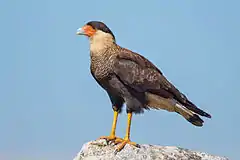| Caracara[1] | |||
| Merrem, 1826[2] | |||
 Przedstawiciel rodzaju – karakara czubata (C. plancus) | |||
| Systematyka | |||
| Domena | |||
|---|---|---|---|
| Królestwo | |||
| Typ | |||
| Podtyp | |||
| Gromada | |||
| Podgromada | |||
| Infragromada | |||
| Rząd | |||
| Rodzina | |||
| Podrodzina | |||
| Plemię | |||
| Rodzaj |
Caracara | ||
| Typ nomenklatoryczny | |||
|
Falco plancus J.F. Miller, 1777 | |||
| Synonimy | |||
|
| |||
| Gatunki | |||
| |||
Caracara – rodzaj ptaków z podrodziny sokołów (Falconinae) w rodzinie sokołowatych (Falconidae).
Zasięg występowania
Morfologia
Długość ciała 49–64 cm, rozpiętość skrzydeł 107–133 cm; masa ciała 907–1600 g[7].
Systematyka
Etymologia
- Caracara: tupi. nazwa Caracará „głośno wrzeszczeć”, dla karakar[8].
- Plancus: łac. plancus lup plangus „gatunek orła”, od gr. πλαγγος plangos „orzeł”[8]. Nomen nudum.
- Polyborus: gr. πολυβορος poluboros „nienasycony, chciwy”, od πολυς polus „dużo”; -βορος -boros „-pożerający”, od βιβρωσκω bibrōskō „zjeść”[8]. Gatunek typowy: Falco plancus J.F. Miller, 1777.
- Lagopterus: rodzaj Lagopus Fraser, 1844 (myszołów); gr. πτερον pteron „skrzydło”[8]. Gatunek typowy: †Lagopterus minutus Moreno & Mercerat, 1891.
- Asthenopterus: gr. ασθενης asthenēs „nieistotny, znikomy”; πτερον pteron „skrzydło”[8]. Nowa nazwa dla Lagopterus Moreno & Mercerat, 1891, ponieważ Ameghino błędnie uważał, że nazwa ta jest zajęta przez Lagoptera Guenée, 1852 (Lepidoptera).
Podział systematyczny
Do rodzaju należą następujące gatunki[9]:
- Caracara plancus J.F. Miller, 1777 – karakara czubata
- Caracara lutosa (Ridgway, 1876) – karakara meksykańska – takson wymarły około 1900 roku[10]
oraz wymarłe w czasach prehistorycznych gatunki:
Przypisy
- ↑ Caracara, [w:] Integrated Taxonomic Information System (ang.).
- ↑ B. Merrem: Caracara. W: J.S. Ersch, J.G. Gruber: Allgemeine Encyclopädie der Wissenschaften und Künste. Leipzig: F. A. Brockhaus, 1826, s. 159. (niem.).
- ↑ C.S. Rafinesque: Analyse de la nature, or, Tableau de l’univers et des corps organisés. Palerme: Aux dépens de l’auteur, 1815, s. 69. (fr.).
- ↑ L.J.P. Vieillot: Analyse d’une nouvelle ornithologie élémentaire. Paris: Deteville, libraire, rue Hautefeuille, 1816, s. 22. (fr.).
- 1 2 F.P. Moreno & A. Mercerat. Catalogue des Oiseaux Fossiles de la Republique Argentine conserves au Musee de la Plata. „Anales del Museo de la Plata”. 1, s. 66, 1891. (fr.).
- ↑ F. Ameghino. Enumeración de las aves fósiles de la República Argentina. „Revista argentina de historia natural”. 1 (6), s. 443, 1891. (hiszp.).
- 1 2 D.W. Winkler, S.M. Billerman & I.J. Lovette: Falcons and Caracaras (Falconidae), version 1.0. W: S.M. Billerman, B.K. Keeney, P.G. Rodewald & T.S. Schulenberg (red.): Birds of the World. Ithaca, NY: Cornell Lab of Ornithology, 2020. DOI: 10.2173/bow.falcon1.01. [dostęp 2020-10-16]. (ang.).

- 1 2 3 4 5 Etymologia za: James A. Jobling: The Key to Scientific Names. [w:] Birds of the World [on-line]. Cornell Laboratory of Ornithology, Ithaca, NY, USA, 2021. (ang.).
- ↑ Systematyka i nazwy polskie za: P. Mielczarek & M. Kuziemko: Plemię: Polyborini Bonaparte, 1838 (1837) (wersja: 2021-01-16). [w:] Kompletna lista ptaków świata [on-line]. Instytut Nauk o Środowisku Uniwersytetu Jagiellońskiego. [dostęp 2021-07-19].
- ↑ BirdLife International, Caracara lutosa, [w:] The IUCN Red List of Threatened Species 2020, wersja 2020-2 [dostęp 2021-02-08] (ang.).
- ↑ F.A. Wetmore. Five new species of birds from cave deposits in Porto Rico. „Proceedings of the Biological Society of Washington”. 33, s. 77–82, 1920. (ang.).
- ↑ P. Brodkorb. Pleistocene Birds from New Providence Island, Bahamas. „Bulletin of the Florida State Museum”. Biological Sciences. 4 (11), s. 349–371, 1959. (ang.).
- ↑ S.L. Olson. A New Species of Large, Terrestrial Caracara from Holocene Deposits in Southern Jamaica (Aves: Falconidae). „Journal of Raptor Research”. 42 (4), s. 265–272, 2008. DOI: 10.3356/JRR-08-18.1. (ang.).
- ↑ W. Jones, A. Rinderknecht, R. Migotto & R.E. Blanco. Body mass estimations and paleobiological inferences on a new species of large caracara (Aves, Falconidae) from the Late Pleistocene of Uruguay. „Journal of Paleontology”. 87 (1), s. 151–158, 2013. DOI: 10.1666/12-026R.1. (ang.).
- ↑ W. Suárez & S.L. Olson. A new fossil species of small crested caracara (Aves: Falconidae: Caracara) from the Pacific lowlands of western South America. „Proceedings of the Biological Society of Washington”. 127 (2), s. 299–310, 2014. DOI: 10.2988/0006-324X-127.2.299. (ang.).
This article is issued from Wikipedia. The text is licensed under Creative Commons - Attribution - Sharealike. Additional terms may apply for the media files.